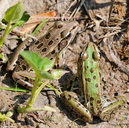|
Description
This frog is generally slim, with a narrow head and long legs. Its distinguishing features are its lack of digital pads, and an upper jaw with teeth. Its dorsolateral folds extend nearly to the hips. The head of the frog is narrow and pointed, and longer than it is broad. The tympanum is about the size of its eye. The body is slender, with its widest region around the bellow, which is smooth and white. There is a dorsolateral fold that originates behind each eye and continues posteriorly to the hips, with smaller, less extensive, longitudinal folds between the dorsolateral folds. The fore limbs are moderately slender, with fingers at the base that do not end in digital pads. The hind limbs are long and moderately slender. Two and a half joints of the longest toe are free of the web, the one join of the other toes if free of the web. The toes do not terminate in digital pads. The male vocal pouches are sausage-shaped sacs at the angles of the jaw. The usually cannot be seen unless they are calling to other individuals. There are two rounded patches of vomerine teeth between the internal nares and the maxillary teeth are found along the upper jaw. The back and sides are green or brown, with distinct round white spots. There is usually a rounded white dot in the center of each tympanum (Carr and Goin 1955). . Distribution and Habitat
Country distribution from AmphibiaWeb's database: United States U.S. state distribution from AmphibiaWeb's database: Alabama, Arkansas, District of Columbia, Delaware, Florida, Georgia, Iowa, Illinois, Indiana, Kansas, Kentucky, Louisiana, Maryland, Missouri, Mississippi, North Carolina, New Jersey, New York, Ohio, Oklahoma, Pennsylvania, South Carolina, Tennessee, Texas, Virginia
The R. sphenocephala is found state-wide in Florida, in all kinds of wet areas (Carr and Goin 1955). Life History, Abundance, Activity, and Special Behaviors
Usually, breeding is initiated by the rain, prompting the males to call out to the females. R. sphenocephala , however, can be heard calling during any month of the year, except July and August (Sunquist et al 2002). Breeding calls are harsh, guttaral croaks (Carr and Goin 1955). Trends and Threats
One decline of this species is currently being researched on Long Island (NY). Southern leopard frogs were historically abundant in many locations throughout the island despite being on the northern terminus of their range. However the frogs appear to have suffered rapid and steady declines throughout the island over the past 15-30 years and may now be extirpated entirely. Intensive efforts are currently underway to investigate the status of this species on Long Island as well as possible decline causes and future conservation potential. This species occurs in a few other locales in New York State but its status is largely unknown. The southern leopard frog is listed as a Species of Special Concern in New York State. (Contributed by Jeremy Feinberg [Jerfein AT eden.rutgers.edu].) Comments
See another account at californiaherps.com.
References
Carr, A. and Goin, C. J. (1955). Guide to the Reptiles, Amphibians, and Fresh-Water Fishes of Florida. University of Florida Press, Gainsville.
Sunquist, F., Sunquist, M., and Beletsky, L. (2002). Florida - The Ecotravellers' Wildlife Guide. Academic Press, San Diego.
Originally submitted by: Theresa Ly, Jeremy Feinberg (first posted 2004-03-23)
Edited by: Tate Tunstall (2006-11-14)Species Account Citation: AmphibiaWeb 2006 Rana sphenocephala: Southern Leopard Frog (R. s. sphenocephala) <https://amphibiaweb.org/species/5174> University of California, Berkeley, CA, USA. Accessed Jun 3, 2025.
Feedback or comments about this page.
Citation: AmphibiaWeb. 2025. <https://amphibiaweb.org> University of California, Berkeley, CA, USA. Accessed 3 Jun 2025.
AmphibiaWeb's policy on data use.
|






 Map of Life
Map of Life